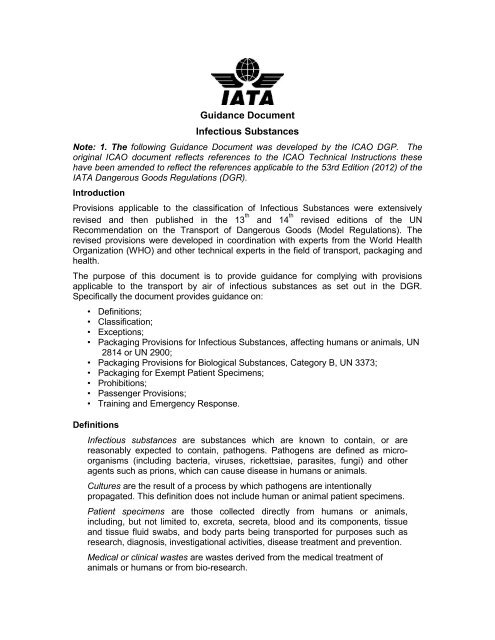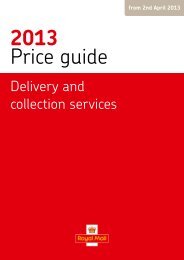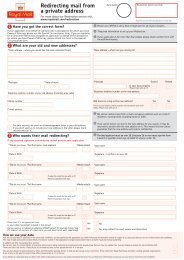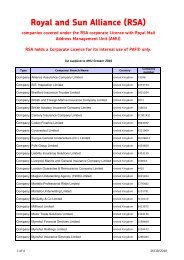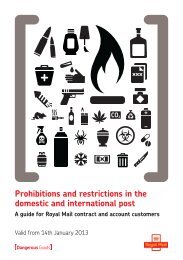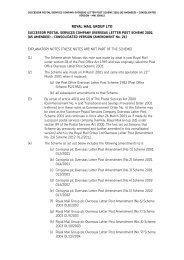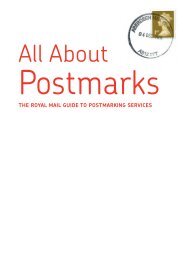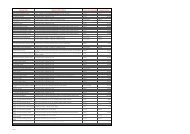IATA Guidance Document on Infectious Substances - Post Office
IATA Guidance Document on Infectious Substances - Post Office
IATA Guidance Document on Infectious Substances - Post Office
You also want an ePaper? Increase the reach of your titles
YUMPU automatically turns print PDFs into web optimized ePapers that Google loves.
<str<strong>on</strong>g>Guidance</str<strong>on</strong>g> <str<strong>on</strong>g>Document</str<strong>on</strong>g><br />
<strong>Infectious</strong> <strong>Substances</strong><br />
Note: 1. The following <str<strong>on</strong>g>Guidance</str<strong>on</strong>g> <str<strong>on</strong>g>Document</str<strong>on</strong>g> was developed by the ICAO DGP. The<br />
original ICAO document reflects references to the ICAO Technical Instructi<strong>on</strong>s these<br />
have been amended to reflect the references applicable to the 53rd Editi<strong>on</strong> (2012) of the<br />
<str<strong>on</strong>g>IATA</str<strong>on</strong>g> Dangerous Goods Regulati<strong>on</strong>s (DGR).<br />
Introducti<strong>on</strong><br />
Provisi<strong>on</strong>s applicable to the classificati<strong>on</strong> of <strong>Infectious</strong> <strong>Substances</strong> were extensively<br />
revised and then published in the 13 th and 14 th revised editi<strong>on</strong>s of the UN<br />
Recommendati<strong>on</strong> <strong>on</strong> the Transport of Dangerous Goods (Model Regulati<strong>on</strong>s). The<br />
revised provisi<strong>on</strong>s were developed in coordinati<strong>on</strong> with experts from the World Health<br />
Organizati<strong>on</strong> (WHO) and other technical experts in the field of transport, packaging and<br />
health.<br />
The purpose of this document is to provide guidance for complying with provisi<strong>on</strong>s<br />
applicable to the transport by air of infectious substances as set out in the DGR.<br />
Specifically the document provides guidance <strong>on</strong>:<br />
• Definiti<strong>on</strong>s;<br />
• Classificati<strong>on</strong>;<br />
• Excepti<strong>on</strong>s;<br />
• Packaging Provisi<strong>on</strong>s for <strong>Infectious</strong> <strong>Substances</strong>, affecting humans or animals, UN<br />
2814 or UN 2900;<br />
• Packaging Provisi<strong>on</strong>s for Biological <strong>Substances</strong>, Category B, UN 3373;<br />
• Packaging for Exempt Patient Specimens;<br />
• Prohibiti<strong>on</strong>s;<br />
• Passenger Provisi<strong>on</strong>s;<br />
• Training and Emergency Resp<strong>on</strong>se.<br />
Definiti<strong>on</strong>s<br />
<strong>Infectious</strong> substances are substances which are known to c<strong>on</strong>tain, or are<br />
reas<strong>on</strong>ably expected to c<strong>on</strong>tain, pathogens. Pathogens are defined as microorganisms<br />
(including bacteria, viruses, rickettsiae, parasites, fungi) and other<br />
agents such as pri<strong>on</strong>s, which can cause disease in humans or animals.<br />
Cultures are the result of a process by which pathogens are intenti<strong>on</strong>ally<br />
propagated. This definiti<strong>on</strong> does not include human or animal patient specimens.<br />
Patient specimens are those collected directly from humans or animals,<br />
including, but not limited to, excreta, secreta, blood and its comp<strong>on</strong>ents, tissue<br />
and tissue fluid swabs, and body parts being transported for purposes such as<br />
research, diagnosis, investigati<strong>on</strong>al activities, disease treatment and preventi<strong>on</strong>.<br />
Medical or clinical wastes are wastes derived from the medical treatment of<br />
animals or humans or from bio-research.
Classificati<strong>on</strong><br />
For transport purposes the classificati<strong>on</strong> of infectious substances according to risk<br />
groups was removed from the DGR in the 46 th editi<strong>on</strong> (2005).<br />
<strong>Infectious</strong> substances are now classified either as Category A or Category B.<br />
There is no direct relati<strong>on</strong>ship between Risk Groups and categories A and B.<br />
Category A <strong>Infectious</strong> <strong>Substances</strong> are infectious substances in a form that, when<br />
exposure to it occurs, is capable of causing permanent disability, life-threatening or fatal<br />
disease in otherwise healthy humans or animals. They are assigned the following UN<br />
numbers and proper shipping names:<br />
. • UN 2814 – <strong>Infectious</strong> Substance, affecting humans; or<br />
. • UN 2900 – <strong>Infectious</strong> Substance, affecting animals <strong>on</strong>ly.<br />
Assignment to UN 2814 or UN 2900 is to be based <strong>on</strong> the known medical history and<br />
symptoms of the source human or animal, endemic local c<strong>on</strong>diti<strong>on</strong>s, or professi<strong>on</strong>al<br />
judgment c<strong>on</strong>cerning individual circumstances of the source human or animal. If there is<br />
any doubt as to whether or not a pathogen falls within this category it must be<br />
transported as a Category A <strong>Infectious</strong> Substance.<br />
Clinical wastes c<strong>on</strong>taining Category A infectious substances must be assigned to UN<br />
2814 or UN 2900, as appropriate.<br />
To assist in the assignment of an infectious substance into Category A see the Indicative<br />
List provided in Table 3.6.D in the DGR. That list, however is not exhaustive. <strong>Infectious</strong><br />
substances, including new or emerging pathogens, which do not appear in the table but<br />
which meet the same criteria must be assigned to Category A.<br />
Category B <strong>Infectious</strong> <strong>Substances</strong> are <strong>Infectious</strong> <strong>Substances</strong> that do not meet the<br />
criteria for inclusi<strong>on</strong> in Category A. They are assigned the following UN number and<br />
proper shipping name:<br />
• UN 3373 – Biological Substance, Category B<br />
Clinical wastes c<strong>on</strong>taining Category B infectious substances must be assigned to UN<br />
3291.<br />
Further assistance <strong>on</strong> the classificati<strong>on</strong> of infectious substances can be obtained from<br />
the nati<strong>on</strong>al health or veterinary authority. (See Annex 1 for Classificati<strong>on</strong> Scenarios and<br />
Annex 2 for a Classificati<strong>on</strong> Flowchart.)<br />
Excepti<strong>on</strong>s<br />
• <strong>Substances</strong>, which do not c<strong>on</strong>tain infectious substances, or substances, which<br />
are unlikely to cause disease in humans or animals, are not subject to the <str<strong>on</strong>g>IATA</str<strong>on</strong>g> DGR<br />
unless they meet the criteria for inclusi<strong>on</strong> in another class;<br />
• <strong>Substances</strong> c<strong>on</strong>taining micro-organisms, which are n<strong>on</strong>-pathogenic to humans or<br />
animals are not subject to the DGR unless they meet the criteria for inclusi<strong>on</strong> in another<br />
class;<br />
• <strong>Substances</strong> in a form that any present pathogens have been neutralized or<br />
inactivated such that they no l<strong>on</strong>ger pose a health risk are not subject to the DGR unless<br />
they meet the criteria for inclusi<strong>on</strong> in another class;<br />
• Envir<strong>on</strong>mental samples (including food and water samples), which are not<br />
c<strong>on</strong>sidered to pose a significant risk of infecti<strong>on</strong>, are not subject to the DGR unless they
meet the criteria for inclusi<strong>on</strong> in another class;<br />
• Dried blood spots, collected by applying a drop of blood <strong>on</strong>to absorbent material,<br />
or faecal occult blood screening tests and blood or blood comp<strong>on</strong>ents which have been<br />
collected for the purposes of transfusi<strong>on</strong> or for the preparati<strong>on</strong> of blood products to be<br />
used for transfusi<strong>on</strong> or transplantati<strong>on</strong> and any tissues or organs intended for use in<br />
transplantati<strong>on</strong> are not subject to the DGR;<br />
• Patient specimens for which there is minimal likelihood that pathogens are<br />
present are not subject to the DGR if the specimen is transported in Packaging for<br />
Exempt Patient Specimens (see below for the Packaging requirements for Exempt<br />
Patient Specimens).<br />
Note:<br />
In determining whether a patient specimen has a minimal likelihood that pathogens<br />
are present, an element of professi<strong>on</strong>al judgment is required to determine if a<br />
substance is exempt under this paragraph. That judgment should be based <strong>on</strong> the<br />
known medical history, symptoms and individual circumstances of the source,<br />
human or animal, and endemic local c<strong>on</strong>diti<strong>on</strong>s. Examples of specimens which may<br />
be transported under this paragraph include the blood or urine tests to m<strong>on</strong>itor<br />
cholesterol levels, blood glucose levels, horm<strong>on</strong>e levels, or prostate specific antigens<br />
(PSA); tests required to m<strong>on</strong>itor organ functi<strong>on</strong> such as heart, liver or kidney functi<strong>on</strong><br />
for humans or animals with n<strong>on</strong>-infectious diseases, or therapeutic drug m<strong>on</strong>itoring;<br />
tests c<strong>on</strong>ducted for insurance or employment purposes and are intended presence of<br />
drugs or alcohol; pregnancy tests; biopsies to detect cancer; and antibody detecti<strong>on</strong><br />
in humans or animals in the absence of any c<strong>on</strong>cern for infecti<strong>on</strong> (e.g. evaluati<strong>on</strong> of<br />
vaccine induced immunity, diagnosis of autoimmune disease, etc.).<br />
Packaging for Exempt Patient Specimens<br />
Patient specimens (human or animal) that have a minimal likelihood of c<strong>on</strong>taining<br />
pathogens must be packaged appropriately to further minimize the risk of exposure.<br />
While these specimens have a minimal likelihood of c<strong>on</strong>taining infectious pathogens in a<br />
form that would cause infecti<strong>on</strong>, appropriate packaging further minimizes the risk of<br />
exposure. Exempt human or animal specimens must be packaged and marked<br />
according to the following:<br />
(i) a leak-proof primary receptacle(s);<br />
(ii) a leak-proof sec<strong>on</strong>dary packaging; and<br />
(iii) an outer packaging of adequate strength for its capacity, mass and intended use,<br />
and with at least <strong>on</strong>e surface having minimum dimensi<strong>on</strong>s of 100 mm × 100 mm;<br />
For liquids, absorbent material in sufficient quantity to absorb the entire c<strong>on</strong>tents must<br />
be placed between the primary receptacle(s) and the sec<strong>on</strong>dary packaging so that,<br />
during transport, any release or leak of a liquid substance will not reach the outer<br />
packaging and will not compromise the integrity of the cushi<strong>on</strong>ing material. When<br />
multiple fragile primary receptacles are placed in a single sec<strong>on</strong>dary packaging, they<br />
must be either individually wrapped or separated to prevent c<strong>on</strong>tact between them. If<br />
such a packaging is used it must be marked "Exempt human specimen" or "Exempt<br />
animal specimen", as appropriate. (See Annex 5 for a graphic depicti<strong>on</strong> of an Exempt<br />
Patient Specimen Packaging)<br />
If other dangerous goods are present with patient specimens the relevant provisi<strong>on</strong>s<br />
of the DGR apply to those goods.<br />
When dangerous goods intended for air transport are carried by surface transport to or
from an airport, any other applicable nati<strong>on</strong>al or modal transport requirements should be<br />
met in additi<strong>on</strong> to those that are applicable for the goods when carried by air.<br />
Packaging Provisi<strong>on</strong>s for <strong>Infectious</strong> <strong>Substances</strong>, humans or animals, UN 2814 or<br />
UN<br />
Packing Instructi<strong>on</strong> 620 in the DGR specifies the type of packaging required for all<br />
Category A infectious substances. All other applicable provisi<strong>on</strong>s of the DGR apply<br />
(See Annex 3 for a graphic depicti<strong>on</strong> of a package c<strong>on</strong>taining category A infectious<br />
substances).<br />
Packaging Provisi<strong>on</strong>s for Biological <strong>Substances</strong>, Category B, Clinical<br />
Specimens, Diagnostic Specimens, UN 3373<br />
Packing Instructi<strong>on</strong> 650 in the DGR provides all the informati<strong>on</strong> necessary to prepare<br />
and transport Category B infectious substances (See Annex 4 for a graphic depicti<strong>on</strong><br />
of a package c<strong>on</strong>taining category B infectious substances).<br />
Prohibiti<strong>on</strong>s<br />
A live animal that has been intenti<strong>on</strong>ally infected and is known or suspected to<br />
c<strong>on</strong>tain an infectious substance must not be transported by air unless the infectious<br />
substance c<strong>on</strong>tained cannot be c<strong>on</strong>signed by any other means. Infected animals may<br />
<strong>on</strong>ly be transported under terms and c<strong>on</strong>diti<strong>on</strong>s approved by the appropriate nati<strong>on</strong>al<br />
authority.<br />
Passenger Provisi<strong>on</strong>s<br />
Category A or B <strong>Infectious</strong> <strong>Substances</strong> are not permitted for transport in carry-<strong>on</strong> or<br />
checked baggage and must not be carried <strong>on</strong> a pers<strong>on</strong>. Packages c<strong>on</strong>taining Exempt<br />
human or animal specimens may be carried in checked or carry-<strong>on</strong> baggage provided<br />
that they meet the applicable packaging requirements.<br />
Training and Emergency Resp<strong>on</strong>se<br />
Effective employee training and appropriate emergency resp<strong>on</strong>se procedures<br />
are required to significantly minimize the risk of exposure and subsequent<br />
transmissi<strong>on</strong> of infecti<strong>on</strong> or disease.
Mitigati<strong>on</strong> procedure:<br />
DO NOT CLEAN-UP OR DISPOSE OF INFECTIOUS SUBSTANCES, EXCEPT<br />
UNDER SUPERVISION OF A SPECIALIST.<br />
- Isolate spill or leak area immediately.<br />
- Keep unauthorized pers<strong>on</strong>nel away.<br />
- Obtain identity of substance involved if possible and report the spill to the<br />
appropriate authorities.<br />
- Do not touch or walk through spilled material.<br />
- Do not touch damaged c<strong>on</strong>tainers or spilled material unless wearing appropriate<br />
protective clothing.<br />
- Be particularly careful to avoid c<strong>on</strong>tact with broken glass or sharp objects that may<br />
cause cuts or abrasi<strong>on</strong>s that could significantly increase the risk of exposure.<br />
- Damaged packages c<strong>on</strong>taining solid CO2 (dry ice) used as a refrigerant may produce<br />
water or frost from c<strong>on</strong>densati<strong>on</strong> of air. Do not touch this liquid as it could be<br />
c<strong>on</strong>taminated by the c<strong>on</strong>tents of the parcel.<br />
- Liquid nitrogen may be present and can cause severe burns.<br />
- Absorb spilled materials with earth, sand or other n<strong>on</strong>-combustible material while<br />
avoiding direct c<strong>on</strong>tact.<br />
- Cover damaged package or spilled material with damp towel or rag and keep wet<br />
with liquid bleach or other disinfectant. Liquid bleach will generally effectively<br />
inactivate the released substance.<br />
First Aid:<br />
- Move exposed pers<strong>on</strong>(s) to a safe isolated area.<br />
CAUTION: Exposed pers<strong>on</strong>(s) may be a source of c<strong>on</strong>taminati<strong>on</strong>. Pers<strong>on</strong>s<br />
administering first aid should take precauti<strong>on</strong>s to avoid pers<strong>on</strong>al exposure or<br />
sec<strong>on</strong>dary c<strong>on</strong>taminati<strong>on</strong> of others.<br />
- Call emergency medical services.<br />
- If clothing and/or shoes are significantly c<strong>on</strong>taminated, remove and isolate them.<br />
However, do not allow this to delay other first aid interventi<strong>on</strong>s.<br />
- In case of c<strong>on</strong>tact of the substance to skin, eyes, nose or mouth, immediately flush<br />
the exposed area with copious amounts of running water. C<strong>on</strong>tinue this until<br />
emergency medical services arrives. Follow their advice for further dec<strong>on</strong>taminati<strong>on</strong>.<br />
- Most effects of exposure (inhalati<strong>on</strong>, ingesti<strong>on</strong> or skin c<strong>on</strong>tact) to substance are<br />
likely to be delayed.<br />
- Ensure that medical pers<strong>on</strong>nel are aware of the substances involved so they can take<br />
precauti<strong>on</strong>s to protect themselves.<br />
For further assistance, c<strong>on</strong>tact the appropriate public health authority
ANNEX 1 - Classificati<strong>on</strong> Scenarios<br />
1. A blood sample known or reas<strong>on</strong>ably suspected to c<strong>on</strong>tain EBOLA VIRUS.<br />
Appropriate classificati<strong>on</strong>: <strong>Infectious</strong> substances, affecting humans UN 2814.<br />
2. A culture of FOOT AND MOUTH DISEASE. Appropriate classificati<strong>on</strong>:<br />
<strong>Infectious</strong> substances, affecting animals, UN 2900.<br />
3. A blood sample taken from a patient known or suspected to have a category B<br />
pathogen, such as HEPATITIS B or HIV. Appropriate classificati<strong>on</strong>: Biological<br />
substance, category B, UN 3373.<br />
4. Culture of BOVINE TUBERCULOSIS. Appropriate classificati<strong>on</strong>: Biological<br />
substance, category B, UN 3373.<br />
5. Laboratory stock culture of a pathogen in category B, e.g. INFLUENZA VIRUS.<br />
Appropriate classificati<strong>on</strong>: Biological substance, category B, UN 3373.<br />
Specimen c<strong>on</strong>taining a category A or B infectious substance, treated so as to<br />
inactivate or neutralise the pathogens such that they no l<strong>on</strong>ger pose a health risk.<br />
Appropriate classificati<strong>on</strong>: Not subject to the transport requirements for<br />
dangerous goods, unless meeting the criteria for another class or divisi<strong>on</strong>.<br />
6. Patient specimens other than those known or reas<strong>on</strong>ably suspected to c<strong>on</strong>tain a<br />
category A infectious substance e.g. those sent for testing for Cholesterol<br />
(blood), diabetes (urine), bowel cancer (faecal).Appropriate classificati<strong>on</strong>: this<br />
will depend <strong>on</strong> professi<strong>on</strong>al judgment, i.e.:<br />
i. If a professi<strong>on</strong>al judgment is made that there is <strong>on</strong>ly a minimal likelihood<br />
that pathogens are present, the specimen is not subject to the provisi<strong>on</strong>s<br />
of the DGR, provided they are packed in accordance with the provisi<strong>on</strong>s<br />
detailed under “Packaging for Exempt Patient Specimens” in this<br />
<str<strong>on</strong>g>Guidance</str<strong>on</strong>g> <str<strong>on</strong>g>Document</str<strong>on</strong>g>;<br />
ii. If no professi<strong>on</strong>al judgment is made, the specimen must be classified<br />
as UN3373.
ANNEX 2 – Classificati<strong>on</strong> Flowchart
ANNEX 3<br />
Example of Packing and Marking for Category A <strong>Infectious</strong><br />
<strong>Substances</strong><br />
(See Packing Instructi<strong>on</strong> 620 for additi<strong>on</strong>al requirements)<br />
Notes:
ANNEX 4<br />
Example of Packing and Marking for Category B <strong>Infectious</strong> <strong>Substances</strong><br />
(See Packing Instructi<strong>on</strong> 650 for additi<strong>on</strong>al requirements, e.g. drop test)<br />
Notes:
Notes:<br />
ANNEX 5<br />
Example of Packing and Marking for Exempt Specimens


